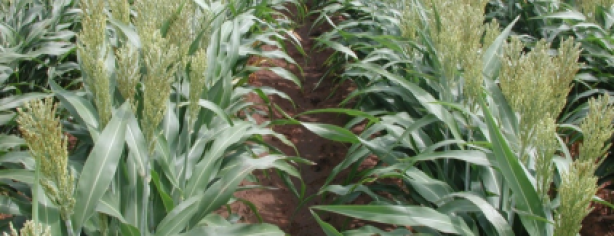Huskie Herbicide: Major addition for weed control in Texas grain sorghum
Highlights
- Over-the-top weed control in grain sorghum
- Excellent control of pigweed and many other broadleaf species
- Greatly reduced injury potential compared to 2,4-D and dicamba
- Atrazine suggested as a key tank mix partner to enhance weed control
Huskie was approved for use in grain sorghum in July 2011. Some producers in the Texas High Plains region used the herbicide in late planted grain sorghum, and they were very pleased with the results. Texas AgriLife staff have researched Huskie since 2009 (brief summary below).
Huskie is labeled for over the top use (POST) in grain sorghum from 3-leaf stage to 12” tall. The herbicide’s active ingredients contain two formulations of chemicals in Buctril and a second a.i. pyrasulfotole. Huskie has demonstrated good post-emerge control on Palmer ameranth and other pigweed species, kochia, species of morninggloery, marestail, henbit, etc. Partial control is noted on bindweed (possession vine) and puncturevine. Best weed control is noted for weeds at ≤ 4” tall.
Also, there are numerous tank mix options particularly atrazine, which is a key for optimum weed control in grain sorghum. In fact, the Huskie label all but encourages use of atrazine to ‘strengthen and expand weed control.’ Atrazine rates, of course, are dependent on soil texture (heavy, light), but tank mix rates range from 0.25-1.0 lbs./A. Other tank mix options include Ally, dicamba, Peak, and Starane. Use spray grade ammonium sulfate (AMS) at 0.5-1.0 lbs./A and non-ionic surfactant (NIS) if the tank mix partner requires it.
Injury Potential is Low
Texas AgriLife notes only minor to ~15% injury to 4-leaf sorghum, with little evidence of injury persisting past 3 weeks. Even less injury has been observed in 8-leaf stage grain sorghum. This is much less than the injury potential from either 2,4-D and dicamba.
Sample of Weed Control Results
High Plains
Bushland – 91%+ control at 7 & 42 days after treatment of 3-4” Palmer ameranth when applied alone at 13-16 oz./A; 95%+ control when applied with 0.5 lb. atrazine at 13 oz./A; adding 4 oz./A dicamba did not improve control.
Halfway – Huskie + atrazine, 94-97% control of 2-4” Palmer ameranth at 21 to 41 days after treatment; slight sorghum injury noted with all POST treatments, but ≤ 5% 21 to 41 DAT unless 2,4-D was included.
Central Texas
No formal trials conducted to date, but Extension observations note that weed control appeared very good and injury potential was low.

Non-treated control

Good Palmer Amaranth Control w/ Huskie + Atrazine
For further information consult the label and your chemical dealer. An expanded summary from Texas AgriLife is available online here.





